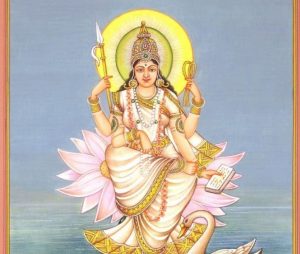Das MahaVidya

The feminine divinity is a powerful entity. From mother nurturers to the destroyers, from knowledge to wealth, they encompass every aspect of the physical and spiritual realm. A part of such a powerful entity is the Mahavidya. The ten Mahavidyas, or Wisdom Goddesses, represent distinct aspects of divinity intent on guiding the spiritual seeker toward liberation. For the devotionally minded seeker, these forms can be approached in a spirit of reverence, love, and increasing intimacy. For a knowledge-oriented seeker, these same forms can represent various states of inner awakening along the path to enlightenment. A Dasa Mahavidya is one of 10 wisdom goddesses in Hinduism. The term comes from the Sanskrit, Dasa, meaning “ten,” maha, meaning “great” and Vidya, meaning “knowledge.” Each Mahavidya is a form of the Divine Mother. In Hindu religious scripts, the Dasa Mahavidya were created after a disagreement between Lord Shiva and Sati (a form of Shakti).
Origin Story of Dasa Mahavidya

Sati, the consort of Shiva was the daughter of Daksha Prajapati, a descendant of Brahma. Sati had married Shiva against the wishes of her father. The vain Daksha performed a great yagna (with the sole aim of insulting Shiva), to which he invited all of the gods and goddesses except his son-in-law, Lord Shiva. Heard about the yajna from Narad Muni, she asked for Shiva’s permission saying that a daughter did not need an invitation from her father. Shiva said that Daksha was trying to insult him, and so even if Sati attended the yajna, the fruit of the sacrifice would not be auspicious. Therefore he attempted to dissuade Sati from attending the yajna. Sati was furious because Shiva was treating her like an ignorant lady and not as the mother of Universe. So to show Shiva who she really was, she assumed a different form – the one of the Divine Mother. The oceans raged, the mountains shook, and the atmosphere was filled with the wonder of her form. It is said that Shiva began to shake and tried to flee. But every direction that he tried to flee, the Divine mother stopped him. The Divine Mother had multiplied herself into ten different forms, guarding each of the ten directions, and try as Shiva might, he could not escape from her, as she had blocked every escape route. These ten forms of Divine Mother are known as the Dasa Mahavidya. Each form has her own name, story, quality, and mantras. Each form of the Divine Mother Kali is a Mahavidya. The Dasa Mahavidyas are: Kālī (Sanskrit: काली) ,Bagalāmukhī (Sanskrit: बगलामुखी),Chinnamastā (Sanskrit: छिन्नमस्ता) ,Bhuvaneśvarī (Sanskrit: भुवनेश्वरी), Mātaṃgī (Sanskrit: मातंगी), Ṣodaśī (Sanskrit: षोडशी), Dhūmāvatī (Sanskrit: धूमावती), Tripurasundarī (Sanskrit: रिपुरसुन्दरी), Tārā (Sanskrit: तारा), Bhairavī (Sanskrit: भैरवी)
KALI MATA
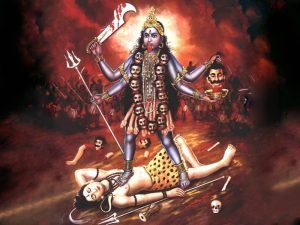
First of all, Sati took the form of Kali. Her form was fearful, her hair untied and loose, her body the color of a dark cloud. She had deep-set eyes and eyebrows shaped like curved swords. She stood on a corpse, and wore a garland of skulls, and earrings made from the bones of corpses. She had four hands – on one hand, she had the head of a skull, and the other a curved sword with blood dripping on it. She had mudras on her other two hands – one giving freedom from fear and the other giving blessings. She roared and the ten directions were filled with that ferocious sound. In the series of the ten Mahavidyas or wisdom aspects of the Divine Mother, Goddess Kali comes first, for she represents the power of consciousness in its highest form. She is at once supreme power and ultimate reality, underscoring the fundamental Tantric teaching that the power of consciousness and consciousness itself are one and the same. The Devimahatmya vividly depicts a scene with Kali and her associated goddesses ready to take on an army of demons. The battle culminates with the slaying of two demon generals, Chanda and Munda, and this act earns her the name Chamunda. In the next episode, Chamunda takes on the demon Raktabija. In the battle, he sheds blood profusely until the world is teeming with Raktabijas. Just when the battle looks hopeless and the onlooking god’s despair, Chamunda roams the battlefield, avidly lapping up the blood and crushing the nascent demons between her gnashing teeth. Finally, drained of his last drop of blood, Raktabija topples lifelessly to the ground. Significance: Raktabija’s amazing replicative ability symbolizes the human mind’s ordinary state of awareness. The mind is constantly in motion, and one thought begets another in an endless succession. The mind rarely rests and is never fully concentrated. In the light of Patanjali’s Yogasutra, we can understand Chamunda as the power to restrain the mind’s endless modulations, to stop them altogether. When all mental activity (chittavritti) ceases, that state is called yoga: consciousness resting in its own infinite peace and bliss. As Dakshinakali, she is portrayed as young and beautiful, standing on the supine, ash-besmeared body of Siva, who looks up at her adoringly. Siva is absolute consciousness, ever blissful in its own glory. Kali is consciousness in motion—the overflowing joy that projects, sustains, and withdraws the universe. Consciousness and its powers are one and the same reality. In general, we can say that all the dualities of life, the light and the dark, the beautiful and the fearsome, are united and reconciled in Kali. She represents supreme non-duality, for she is none other than Brahman. At the same time, the duality of this world is nothing other than her own self-expression. From the Absolute to the relative and from the relative to the Absolute, Kali represents the power of transformation. For us, who wrongly think ourselves to be mere mortals, she holds out the promise of transformation from the human to the Divine.
TARA MATA
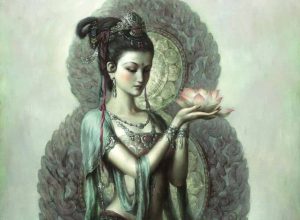
The Goddess Tara is worshipped in both Hinduism and Buddhism as the goddess of compassion and protection. In Hinduism, she is a form of the female primordial energy known as Shakti. The name comes from the Sanskrit root tar, meaning “protection.” In other Indian languages, the name translates as “star.” Tara’s name is derived from tri, which means “to cross.” One of her epithets is Samsaratarini, “she who takes across the ocean of worldly existence.”Tara is thus the all-gracious liberator. Tara first appeared as a deity in Hinduism but was later adopted by Buddhism. In fact, in some traditions, she is considered the female Buddha. In Tibetan Buddhism, she is the most popular deity worshiped today. Origin – It is said that during the churning of the milky sea when poison came out of the ocean, Lord Shiva drank it to save the world from destruction. But Lord Shiva fell unconscious under the powerful effect of the poison. At this point, Goddess Durga appeared as Tara and took Shiva on her lap, and breastfed Him to counteract the effect of the poison. Hence Tara is said to be more approachable to her devotees because of her maternal instinct. In tantric traditions, she may be considered an incarnation of Durga, Parvati or Mahadevi. Goddess Tara protects those on their journey to enlightenment, as well as earthly travelers. In some traditions, Tara appears in different forms; the two best-known versions of her are White Tara, the embodiment of compassion and peace, and Green Tara, who is the great protector and overcomer of obstacles. Images of Tara often show her seated on a white lotus in the midst of the primordial waters that envelop the entire universe. From this, we understand that she is the Mother of the three worlds—of the heavens, the atmosphere, and the earth. Much of Tara’s symbolism can be related to death—but in its broadest perspective. The death it refers to is the death of the ego, the false idea of selfhood that keeps the individual in bondage, ever reactive and in thralldom to all of the life’s ups and downs. Like Kali, Tara is sometimes shown wearing a girdle of severed human arms, a symbol of her ability to relieve us of the burdens of karma. The scissors and sword, rather than being understood as agents of death, should be thought of as tools to dismantle and remove the ego, the sense of mistaken identity that defines, limits, and binds.
Tripura Sundari Mata
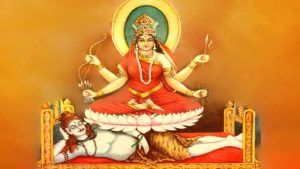
Tripura Sundari is also known as Goddess Shodashi. As the name suggests Goddess Shodashi is the most beautiful in all three worlds. In Mahavidya, She represents Goddess Parvati or also known as Tantric Parvati. Goddess Shodashi is also known as Lalita and Rajarajeshwari which means “the one who plays” and “queen of queens” respectively. Mahavidya is Tripurasundari, also known as Kamala. A form of Mahalakshmi, She symbolizes wealth. According to the description in her dhyana mantra, Tripurasundari’s complexion shines with the light of the rising sun. This rosy color represents joy, compassion, and illumination. She is shown with four arms in which she holds five arrows of flowers, a noose, a goad and sugarcane as a bow. The noose represents attachment, the goad represents repulsion, the sugarcane bow represents the mind and the arrows are the five sense objects. In the Sakta Tantra, it is Mother who is supreme, and the gods are her instruments of expression. Through them, she presides over the creation, maintenance, and dissolution of the universe, as well as over the self-concealment and self-revelation that lie behind those three activities. Self-concealment is the precondition as well as the result of cosmic manifestation, and self-revelation causes the manifest universe to dissolve, disclosing the essential unity. With this in mind, the eighteenth-century commentator Bhaskararaya proposed that the name Tripurasundari should be understood as “she whose beauty precedes the three worlds,” meaning that she is divinity in its transcendental glory. However, the name is usually taken in an immanent sense to mean “she who is beautiful in the three worlds.” Present here is the idea of a triad, a grouping of three that plays out in many different aspects of the phenomenal world. Tripurasundari represents the state of awareness that is also called the sadasivatattva. It is characterized as “I am this” (aham idam). Cosmic evolution is the outward flow of consciousness (pravritti). Spiritual practice reverses that flow, so for the yogin, this stage is a very high level of attainment, close to final realization. It is an experience of the universe within the unity of consciousness. Even in our ordinary state of consciousness, Tripurasundari is the beauty that we see in the world around us. Whatever we perceive externally as beautiful resonates deep within.
BHUVANESHWARI MATA
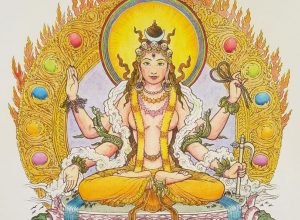
The fourth Mahavidya is Goddess Bhuvaneshvari, whose form closely resembles that of Tripurasundari. Her name consists of two elements: bhuvana, which means this living world—a place of dynamic activity—and isvari, which means the female ruler or sovereign. The name Bhuvanesvari is most often translated as “Mistress of the World,” but bhuvana is more than the earth we stand upon. It is the entire cosmos, the bhuvanatraya, consisting of the heavens, the atmosphere, and the earth. Because this is a living, dynamic phenomenon, Bhuvanesvari embodies all its characteristics and their interaction. She is called Mahamaya (“she whose magical power is great”). Maya here is the power to create a magical appearance for the delight of the spectator; that is what a magician does. She is called Sarvarupa (“she whose form is all”) and Visvarupa (“she whose form is the universe” or “she who appears as the universe”). All that we experience in this life is, in fact, the Divine Mother. As Bhuvanesvari she is consistently associated with the here and now. According to “Pranatoshini Grantha”, Brahma had the desire to create the Universe, and he did intense Tapasya to invite the energy of Creation, Kriya Shakti. Parameswari, pleased with his Tapasya responded to his invitation and came as Bhu Devi or Bhuvanesvari. She is red in color, seated on a lotus flower. Her body is resplendent and shining with jewels. She holds a noose (paasham) and a curved sword (ankusham) in two of her hands and the other two assume the mudras of blessing and freedom from fear. She resides in Shiva’s heart. Bhuvanesvari is the Supreme Empress of Manifested Existence, the exposer of consciousness. Essentially, Bhuvanesvari, by her all-pervasiveness and identification with the universe, invites us to cultivate an attitude of universality.
CHINNAMASTA MATA
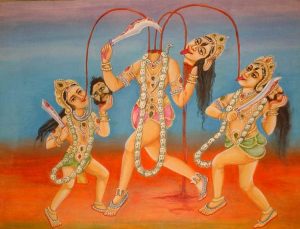
The third Mahavidya is Chinnamasta. She is also known as Prachanda Chandika. Chinnamasta (“she who is decapitated”) is a form of the Divine Mother shown as having cut off her own head. [ This is her story ] Origin Story: According to Panchatantra Grantha once Parvati went with her friends Dakini and Varnini to take a bath in the Mandakini River. Parvati was feeling very happy and a lot of love was welling up inside which caused her complexion to darken and the feeling of love completely took over. Her friends, on the other hand, were hungry and asked Parvati to give them some food. Parvati requested them to wait and said that she would feed them after a while, and began walking. After a short while, her friends once again appealed to her, telling her that she was the Mother of the Universe and they her children and demanded that their hunger be satisfied immediately. The compassionate Parvati laughed and with her fingernail cut her own head. Immediately the blood spurted in three directions. Her two friends drank the blood from two of the directions and the Goddess herself drank the blood from the third direction. Since she cut her own head, she is known as Chinnamasta. Chinnamasta shines like a lightning bolt from the Sun. She demonstrates the rare courage needed to make the highest conceivable sacrifice. The severed head, iconographically, symbolizes liberation. Each person’s individual identity is a state of conditioning or limitation, dependent on qualities. By severing the head, the Mother reveals herself in her true being, which is unconditioned, infinite, and boundlessly free. This idea of freedom is reinforced by her nudity, which symbolizes that she cannot be covered or contained by any garment. Because she is infinite, she is also autonomous. Dakini, on the left, is black; Varnini, on the right, is red. Chinnamasta, in the middle, is white. Black, red, and white represent the three gunas, or basic universal energies. Sattva, symbolized by Chinnamasta’s whiteness, is the highest of the gunas, of course, but all three belong to prakriti, the principle of materiality on which all nature rests. Nothing exists apart from the Mother, whose power of diversification takes form as the grand display of the universe. The blood spurting from Chinnamasta’s neck represents the life force (prana) or cosmic energy that animates the universe and sustains all life. The first stream flows into Chinnamasta’s own mouth. She is self-existent and dependent on no other. The streams that flow into the mouths of her attendants represent the life-force in all living creatures.
BHAIRAVI MATA
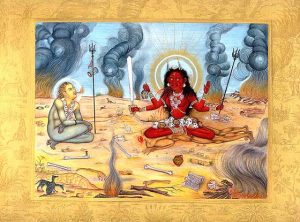
The name Bhairavi means “frightful,” “terrible,” “horrible,” or “formidable.” Goddess Bhairavi provokes different fear, for she is said to shine with the effulgence of ten thousand rising suns. She has many names including Tripura Bhairavi, Sampath Praja Bhairavi, Kaulesh Bhairavi, Siddhida Bhairavi, Bhay Vidwamsi Bhairavi, Chaitanya Bhairavi, Kameshwari Bhairavi, Nitya Bhairavi, and Rudra Bhairavi. Her body is the color of the rising sun. Bhairavi is seen mainly as the Chandi in the Durga Saptashati who slays Chanda and Munda. Sometimes she is in the cremation ground, seated on a headless corpse. Like Kali, she has four arms. With two of her hands, she holds the sword of knowledge and the demon’s head which represents the destruction of the ego. Her other two hands may display the abhayamudra, urging us to have no fear, and the varadamudra, the gesture of granting boons. More often they hold a mala, signifying devotion, and a book, signifying knowledge. The trident represents the pervasively threefold nature of her manifestation and can be interpreted in a variety of ways. It is often said that Bhairavi represents divine wrath, but it is only an impulse of her fierce, maternal protectiveness, aimed at the destruction of ignorance and everything negative that keeps us in bondage. In that aspect, she is called Sakalasiddhibhairavi, the granter of every perfection.
DHUMAVATI MATA
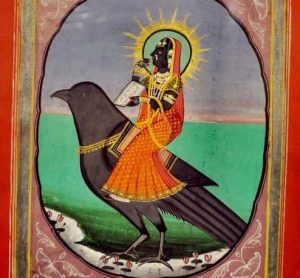
Goddess Dhumavati personifies the dark side of life. Her name means “she who is made of smoke.” Smoke is one of the effects of fire. It is dark and polluting and concealing; it is emblematic of the worst facets of human existence. Origin Story: As per legend mentioned in Pranatoshini Tantra, once Devi Sati due to satiate her extreme hunger swallowed Lord Shiva. Later on the request of Lord Shiva itself, She disgorged Him. After this incident, Lord Shiva rejected Her and cursed Her to assume the form of a widow. A common feature is an association with a crow. The crow sometimes appears emblazoned on Dhumavati’s banner; sometimes it sits atop the banner. Occasionally the bird is shown as huge, serving as her mount (vahana). She is associated with poverty, need hunger, thirst, quarrelsomeness, anger, and negativity. She is consistently shown as old and ugly, with sagging breasts and crooked or missing teeth. She is dressed in filthy rags. Dhumavati is characterized as a widow, and this gives a clue to her unique nature as a Mahavidya and distinguishes her from the earlier goddesses, who are to be avoided. Dhumavati represents the erosive power of time that robs us of loved ones, of our own youthful strength and vitality, of our health, and of whatever else contributes to our fragile happiness. Everything that we so desperately cling to for security is by nature transient. In the end, we all face our own mortality. That is the fundamental problem of human existence.
BAGALAMUKHI MATA
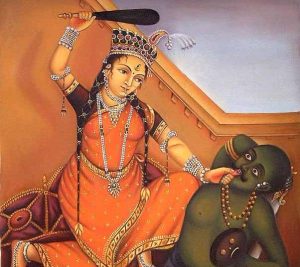
She is also known as Bagala for short and as the “goddess who paralyzes enemies.” In later tantric yoga, Bagalamukhi is associated with the practice of pranayama. Her name is a combination of Bagala and Mukhi. Bagala, which is the distortion of the original Sanskrit root Valga (वल्गा), means bridle. The headgear used to control a horse is known as a bridle. Hence Bagalamukhi means the Goddess who has the power to control and paralyze the enemies. Due to her capturing and paralyzing powers She is also known as Devi of Stambhana In some traditions, she is an incarnation of the goddess Kali. Bagalamukhi translates as “the one who checks the mouth.” She is so-named for her power to silence speech and still the mind. In yoga, such a state helps the yogi find peace and higher states of consciousness/ Origin Story: Once an asura named Ruru, the son of Durgam, performed severe penance to win the favor of Brahma. Since Ruru was already very powerful, the Gods became very apprehensive of what might happen if he obtained a boon from Brahma. So they did Aradhana (propitiation) to yellow water (Shree Maa says here, that yellow intuitively means peace). Pleased with their tapasya, the Divine Mother appeared as Bagala. Bagala is the Goddess who stops all motion at the appropriate time, silences the mouths and words of all evil beings, and controls their tongues. May that Goddess bless us with stillness when it is appropriate!
MATANGI MATA
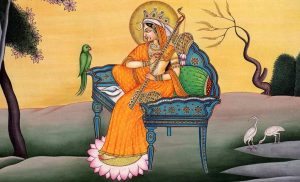
The Shaktisamgama-tantra narrates the birth of Ucchishta-matangini. Once, the god Vishnu and his wife Lakshmi visited Shiva and his second wife Parvati (a reincarnation of Sati) and gave them a banquet of fine foods. While eating, the deities dropped some food on the ground, from which arose a beautiful maiden who asked for their leftovers. The four deities granted her their left-overs as prasad, food made sacred by having been first consumed by the deity. This can be interpreted as the Ucchishta of the deity, although due to its negative connotation the word Ucchishta is never explicitly used in connection to Prasad. Shiva decreed that those who repeat her mantra and worship her will have their material desires satisfied and gain control over foes, declaring her the giver of boons. From that day, the maiden was known as Ucchishta-matangini. Matangi is often described as an outcast and impure. Her association with pollution mainly streams from her relation to outcaste communities, considered to be polluted in Hindu society. These social groups deal in occupations deemed inauspicious and polluted like the collection of waste, meat-processing, and working in cremation grounds. Matangi is regarded as a Tantric form of Saraswati, the goddess of knowledge and the arts of mainstream Hinduism, with whom she shares many traits. Both embody the music and are depicted playing the veena. They are also both said to be the Nada (sound or energy) that flows through the Nadi channels in the body through which life force flows. Both are related to rain clouds, thunder, and rivers. Though both govern learning and speech, Saraswati represents the orthodox knowledge of the Brahmins while Matangi—the wild and ecstatic outcast—embodies the “extraordinary” beyond the boundaries of mainstream society, especially inner knowledge.
KAMALA MATA
